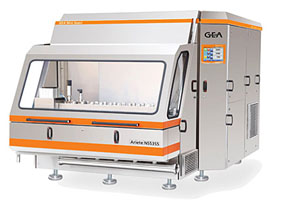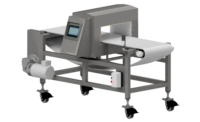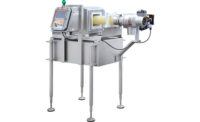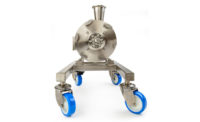
|
|
The NS355 homogenizer, from GEA Niro Soavi, Bedford, N.H., meets the market demand for higher flow rates, It is rated at 355 Kw with flow rates to 60,000 lph at 120 BAR.The machine is available in both aseptic and standard design configurations with internal manufacturing of all core components, for total quality control. www.nirosoavi.com |
Designers of processing equipment recognize some of the economic realities of today. Energy is expensive, so equipment is more efficient. Real estate is expensive, so equipment takes up less space. Labor is expensive, so equipment runs more efficiently and reliably.
In the previous article (“The heart and heat of dairy processing”), equipment vendors talked about the process of pasteurizing milk. In this report, they talk about the technological upgrades and new features they incorporated to their systems.
The Alfa Laval Frontline 15 Automatic offers processors the largest sanitary heat exchanger available in the world, said Carl Lemke of Alfa Laval.
“With 6-inch porting and up to 9,000 square feet of surface, it is almost twice the size of competitive offerings,” Lemke said.
This provides processors operating efficiencies through reduced floor space requirements and the ability to achieve high rates of heat recovery at high flows, with minimum product shear and system pressure drop.
David M. Miles of MicroThermics Inc. said that in the food research industry, his company specializes in thermal process simulation. MicroThermics won the 2011 Industrial Achievement Award for its Direct Indirect UHT/HTST processor because of its ability to truly provide production processing conditions.
“We utilize a number of methods to analyze production processes, and then build equipment to match the time/temperature histories,” Miles said.
The company builds flexibility into its equipment so that it can simulate a wide range of time/temperature histories. Thus, clients can closely simulate the variety of processes found industrially, even within the same “process conditions,” Miles said.
Updates and new features make the equipment easier to use, and MicroThermics provides customers real-time online process support.
“This enables us to log into our clients’ processor and help them troubleshoot or analyze a process in real time. We can literally operate most of their processor from our offices if necessary,” Miles said.
John C. Bohn said AGC Heat Transfer has a new “fixed footprint” automatic hydraulic open-close frame. Model AR51-D allows processors to install a new HTST unit and select a frame size large enough for any future increased flow, he said. Future increases in flow can be easily achieved by addition of plates only and the existing frame will be capable of handling the larger number of plates within the same fixed footprint, Bohn added.
“We’ve also included a simple hydraulic closure system with only two spindles and no PLC (programmable logic controller) so operation is simple and accurate.”
Inline dispersing/milling technology is allowing dairy processors to reduce the pressure on (or completely eliminate) conventional homogenizers, said Rick Earley of Admix Inc. This results in significant savings in water and energy consumption, initial capital investment and ongoing maintenance expense.
Bill Snow said the hydraulic frame closures on the manual and powered versions for SPX Flow Technology Systems’sBinary and Quad Drive plate heat exchanger allow for easy and safe opening and closing. The EasyFlow plate series is said to be highly responsive to clean-in-place procedures. Features include ease of gasket replacement and self-locking alignment features.
One technology improvement from Tetra Pak is a new inlet valve arrangement of the balance tank that reduces the mixing phase of the product by as much as 50%, said Dan Björklund. The inlet solution features an electronic level control and a frequency-controlled product pump that lowers energy consumption even further.
Another area of major improvement is CIP. The latest generation of Tetra Alcip has been fitted with an array of intelligent new functions that reduce water consumption and increase the accuracy of detergent concentration.
The company’s newest Tetra PlantMaster enables an entire line (including filling and logistics systems for packaged and palletized products) to be run by a single automation control system.
“Apart from what this means for plant-wide efficiency and cost reduction, it also enables full traceability. Could this make it possible for a consumer to scan a bar code on a milk package and find out what farm the milk came from? It’s already been done,” Björklund said.



